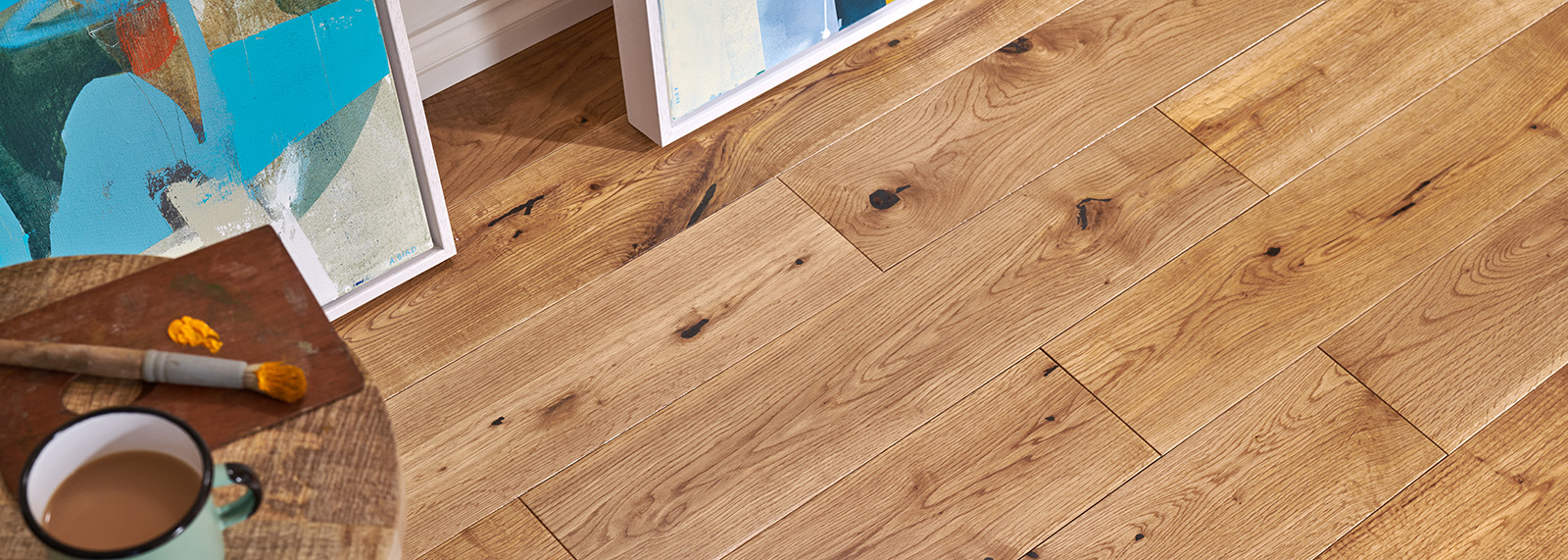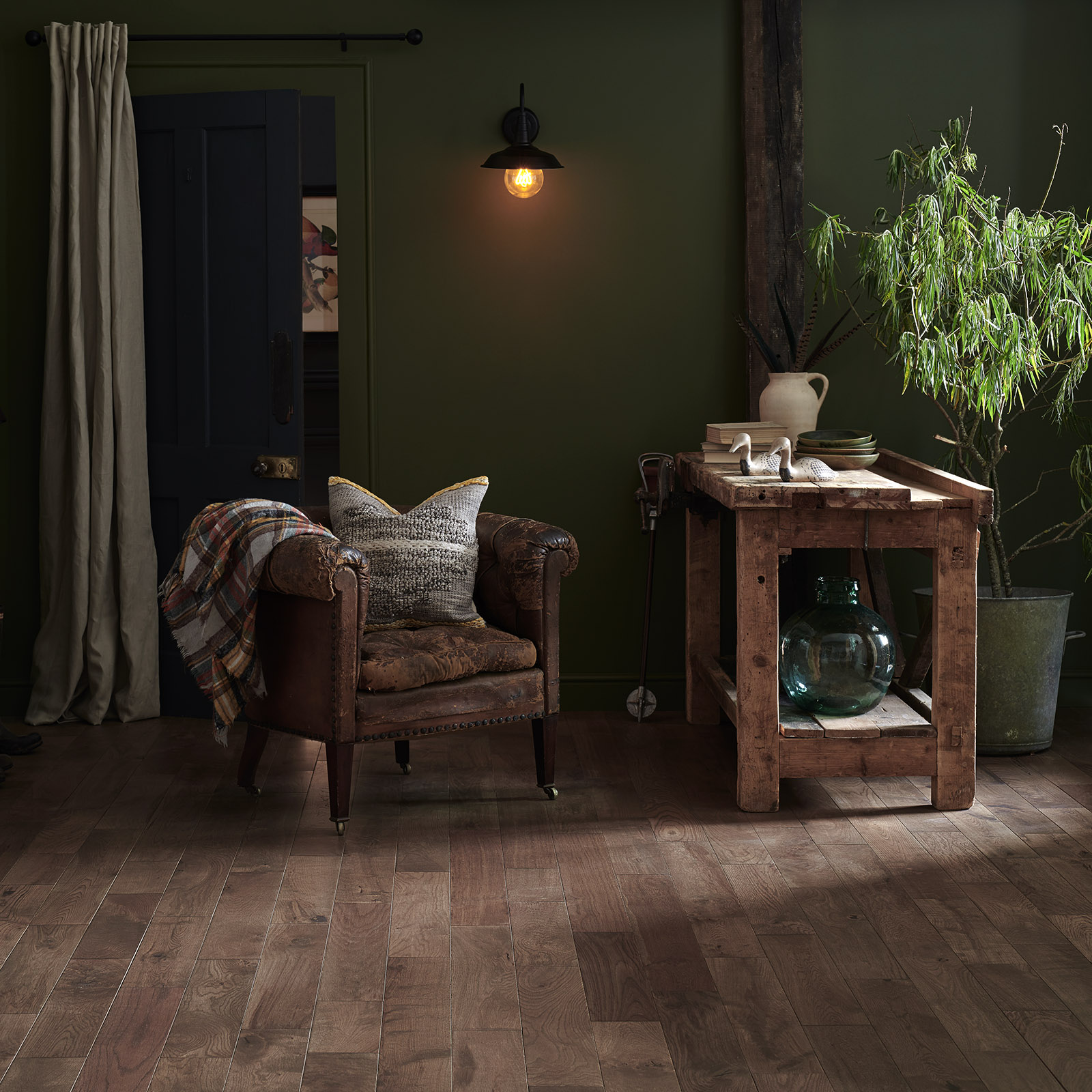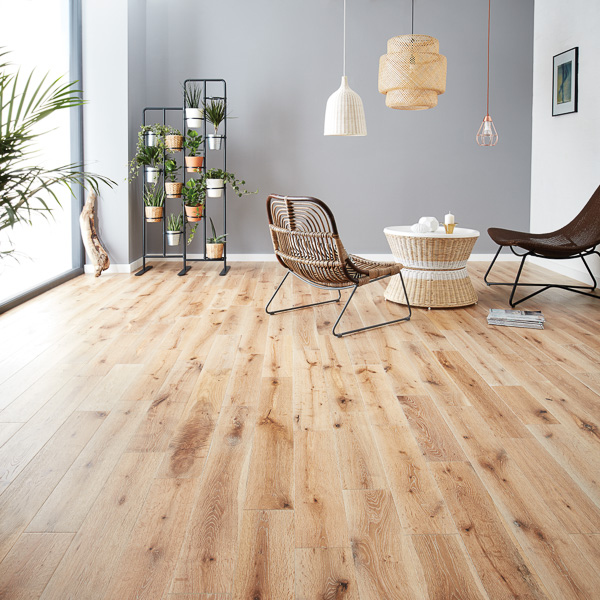Solid Wood Flooring: Your Questions Answered

Thinking of installing solid wood flooring in your home? In this post we’ll answer some of the most common questions we get asked about solid wood flooring, from what it is to where it can, and can’t, be installed.
Overview:
- What is solid wood flooring
- What are the benefits of solid wood flooring
- How to lay solid wood flooring
- What rooms can solid wood flooring be installed in?
- Is solid wood flooring suitable for underfloor heating?
- Is solid wood flooring suitable for pets?
- Negatives of solid wood flooring
- Conclusion
What is Solid Wood Flooring?
Let’s start with the basics. Solid wood floors are made from a single piece of solid hardwood – typically oak but they can be made from maple, walnut and even pine, too. The planks can vary in thickness, width, and length and can also differ in appearance depending on their finish. Oiled and lacquered are the most common types of finishes. These enhance the tree’s colour and add long-lasting protection.
Unlike engineered floors, solid wood floors do not have any structural reinforcement (such as a core layer) which is why they don’t have a ‘wear layer’.
What Are The Benefits of Solid Wood Flooring?
A big advantage of solid wood flooring is that it can be sanded down and refinished time and time again. This is a great benefit for high-traffic areas or homes with pets. Yet there’s nothing unusual about allowing a solid wood floor to mature naturally. Signs of wear can add extra character and a lovely sense of heritage – especially as the colour of the tree can become richer and deeper as it ages.
How to Lay Solid Wood Flooring
Solid wood flooring typically has tongue and groove joints that allow each plank to be slotted together for a neat surface. The planks can either be glued directly to the subfloor, secret nailed over an existing timber subfloor, or (subject to floor thickness) fixed directly above joists to provide a structural floor (always get a second opinion before doing this though).
Since solid wood flooring is a fully natural product that does not have any other structural reinforcement, it is not suitable to be floated as that method wouldn’t allow for natural movement in the wood.
As with all wood floor installations (not just solid wood), the subfloor must be carefully prepared. Levelling, moisture levels, and any issues with damp should all be considered and controlled prior to installation. As solid floors cannot be floated, an underlay would not be suitable, therefore liquid DPM (damp-proof membranes) may be required if additional moisture protection is needed.
What Rooms Can Solid Wood Flooring be Installed In?
Solid hardwood flooring can be a great option for living rooms, bedrooms, and hallways.
The only rooms that aren’t suitable for solid flooring are the bathroom and rooms prone to high moisture levels or excessive water. Wood naturally absorbs and releases moisture from the air and while doing so, its fibres expand and contract. In unstable conditions with fluctuating humidity (such as in the bathroom), solid planks are at risk of this kind of movement, and fitting solid floors in such conditions can result in gapping, cupping, and/or warping on the floor.
Is Solid Wood Flooring Suitable for Underfloor Heating?
Solid wood flooring is not suitable for underflooring heating for similar reasons that it is not suitable for high moisture rooms. As these planks are comprised of a single solid piece of natural wood that’s sensitive to the moisture in its environment, they aren’t stable enough to manage the fluctuations in humidity that arise from heating beneath the floor.
Is Solid Wood Flooring Suitable for Pets?
Solid flooring can be installed in homes with pets. These floors have high finishes which help to protect them from small scratches, it’s also much easier to clean than a carpet and doesn’t harbour the dirt or bacteria in the same way that a carpet does.
Yet as with any floor, there’s always the risk of some damage from furry friends. To try and minimise this risk, we recommend choosing an oiled solid oak floor as scratches are less visible and more easily repaired with this finish. Plus, it’s a good idea to keep coir matting at doorways and to ensure pets are wiped clean and dry when coming in from outside.

Negatives of Solid Wood Flooring
Solid hardwood floors are a very traditional and popular type of flooring, however, they do have some drawbacks so it’s good to understand the limitations that come with this fully natural product before purchasing.
Solid wood floors do not cope well with moisture or temperature changes – as mentioned above, we wouldn’t advise using solid wood floors in high moisture rooms or with underfloor heating. If you do, you may find that your once beautiful floor starts to show signs of gapping, cupping or warping which can be costly and time-consuming to fix.
Engineered wood flooring is the recommended solution for pairing real wood with underfloor heating as it has a central cross-layered core for added stability.
If you’re looking for a floor that you can float, then solid wood floor may not be the choice for you. With a solid wood floor, you need to either fully glue it down or nail it down, therefore floating it and using underlay would not be suitable.
Solid wood planks will vary in length – this may not necessarily be a drawback, but it certainly is something to bear in mind as you will only get random length planks with solid wood due to product availability. This means that more time may be required at the installation stage for measuring up planks and you may have shorter planks that you anticipated.
Whilst solid wood floors are a natural and traditional product that has a sense of charm, it’s not the best choice for the environment as each plank needs to be crafted from the same solid piece of tree – even though at least half of the plank is unlikely to ever be seen. This means that what could be the wear layer for 4 or so engineered planks (depending on thickness), you can only get one solid wood plank from that same amount of oak thus not allowing the tree to go as far as it could.
To Summarise
Solid wood flooring is a great choice if you’re looking for a traditional wood floor for your home, made from a single piece of milled hardwood that will last for years to come. However, it does come with some limitations and there may be better solutions out there if you want a real wood floor but a much more structurally sound and durable floor. For that, we would recommend looking into manufactured engineered flooring as it has all the benefits of solid wood flooring, plus many more.
However, if your heart is set on having a solid wood floor, then take a glance at our range of 18mm solid oak flooring; York. This collection will add charm and character to any space whilst giving you peace of mind with its 100-year warranty.



